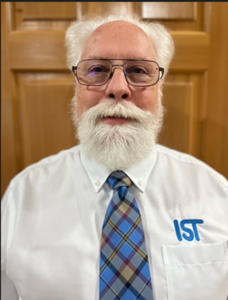For more than two decades, Sean Sullivan, IST America’s Manager, Technical Services and Senior Field Service Technician, has been helping our North American customers optimize the way they bring curing solutions onto their production floors. According to Sean, he’s had ‘ink under his nails’ since he was 11 years old, his journey at IST America started in the sheetfed side of the business, quickly expanding to include all printing and converting formats. Sean’s the senior member of IST America’s technical service team and his passion is training and managing people to ensure the company’s culture of customer care is the best in the industry.
What’s your typical day like at IST America?
I’m generally up by five o’clock, answering emails and then by seven or eight I’m at a customer site. I spend around 80% of my time in the field, working with our technicians or directly with a customer or OEM’s technical and production teams. In my new role as manager of the service department, I plan to work closely with our administrative and technical support people in developing a stronger, more cohesive service team. In our industry, the role of technical support is continually evolving, which is primarily dictated by application demands and the system requirements we’re seeing come into the marketplace. These include much more sophistication and integration of presses and equipment – electronic lamp control, diagnostics, and new ways of interfacing with the OEMs’ platforms. As curing solution providers, we are continually developing new ways of supporting our customers to better understand, operate and manage these systems.
How is IST America’s service culture unique?
Something that sets us apart in our industry is the protocols we have in place for hiring and onboarding technicians. We look for very specific backgrounds, which have then been fine-tuned over the years. In the past we looked for someone with a more mechanical background, and as things changed over the years, we focused primarily on someone familiar with transformer technology and dealing with very high voltages.
Today, technicians should still have an electromechanical background, but we have shifted our hiring practices to people who have more familiarity within a specific industry, along with some application knowledge and expertise within a specific field. Every one of our technicians is very familiar with the printing or converting application process. Effectively tailoring our services to the industries we service has proven to be one of our great strengths, and is something I’m extremely proud of. Another great benefit to our customers is that we do not base all of our technicians out of one central office. They live in our industry’s key regions, so we’re strategically located in each industry pocket. Availability is IST America’s service mantra and a core focus. We are extremely dedicated to partnerships with our clients, along with great relationships with many OEMS.
How have you seen UV technology change over the years, and where do you think it’s headed?
The technology, from conventional UV to LED, has the advantage of simply making the production process faster and the results better. From the quick on/off and formatting of systems, to improved quality, to the reduction of heat to the substrate and equipment, and to easier operation handling. The idea that you’re not waiting for any oxidation of the inks is the beauty of these systems. Heidelberg has sheetfed presses that are now capable of speeds of 18,000 sheets per hour, fully curing with UV, which would have been unheard of a decade ago.
UV has developed into such a critical part of printing, converting and industrial applications due to the technology’s benefits on the widest range of materials and applications. This is also due to the finishing, embellishment and protection options that the technology delivers. The potential to further develop UV into many more unknown areas shows that there is still a high demand for maintaining, exploring and developing this technology and its potential in the marketplace. In order to do this however, as an industry we need to ensure that we have both the people and the skill sets required. Some form of UV technology will continue to be a critical part of the growth and success of many industries. Commercial print, packaging, digital printing, industrial, automotive, converting, medical and purification are all areas that will continue to develop, and those of us at IST America look forward to being part of that transition and to offering production and support solutions.
